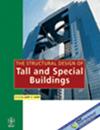Study of the flexural performance and a novel calculation formula for the degree of composite action for precast concrete sandwich panels
IF 1.3
3区 工程技术
Q3 CONSTRUCTION & BUILDING TECHNOLOGY
引用次数: 0
Abstract
Summary This study investigates the flexural performance and degree of composite action (DCA) of precast concrete sandwich panels (PCSPs) with four types of connectors. Five full‐scale specimens were designed, and 4‐point bending tests were performed. The specimens included four PCSPs utilizing glass fiber reinforced polymer (GFRP) truss connectors, steel truss connectors, concrete rib connectors, and GFRP pin connectors, respectively, along with a solid panel (SP). The results indicated that the flexural performance and DCA provided by the four types of connectors followed an ascending order as follows: GFRP pin‐type connectors, GFRP truss connectors, steel truss connectors, and concrete rib‐type connectors. Moreover, the study presented a novel method for calculating DCA, namely, the neutral axis method, which was compared with the displacement and strain methods. The reasonableness and accuracy of the neutral axis method in calculating DCA during the linear elastic stage were verified. Results indicated that the neutral axis method provided more precise and reasonable DCA that closely matched the experimental results compared with the displacement and strain methods. Additionally, the neutral axis method was simpler to calculate DCA and had a broader range of applications. Finally, the study provided recommendations for the optimal application scenarios of each calculation method.研究了预制混凝土夹芯板的抗弯性能及复合作用度计算公式
本研究探讨了预制混凝土夹芯板(pcsp)的抗弯性能和复合作用程度(DCA)。设计了5个全尺寸试件,并进行了4点弯曲试验。试件包括四个pcsp,分别采用玻璃纤维增强聚合物(GFRP)桁架连接器、钢桁架连接器、混凝土肋连接器和GFRP销连接器,以及一个实心面板(SP)。结果表明:4种连接方式的抗弯性能和DCA大小依次为:GFRP销式连接方式、GFRP桁架连接方式、钢桁架连接方式和混凝土肋式连接方式;提出了一种新的计算DCA的方法,即中性轴法,并与位移法和应变法进行了比较。验证了中性轴法计算线弹性阶段DCA的合理性和准确性。结果表明,与位移法和应变法相比,中性轴法提供了更精确、合理的DCA,与实验结果吻合较好。此外,中性轴法计算DCA更简单,适用范围更广。最后,对各种计算方法的最优应用场景提出了建议。
本文章由计算机程序翻译,如有差异,请以英文原文为准。
求助全文
约1分钟内获得全文
求助全文
来源期刊
CiteScore
5.30
自引率
4.20%
发文量
83
审稿时长
6-12 weeks
期刊介绍:
The Structural Design of Tall and Special Buildings provides structural engineers and contractors with a detailed written presentation of innovative structural engineering and construction practices for tall and special buildings. It also presents applied research on new materials or analysis methods that can directly benefit structural engineers involved in the design of tall and special buildings. The editor''s policy is to maintain a reasonable balance between papers from design engineers and from research workers so that the Journal will be useful to both groups. The problems in this field and their solutions are international in character and require a knowledge of several traditional disciplines and the Journal will reflect this.
The main subject of the Journal is the structural design and construction of tall and special buildings. The basic definition of a tall building, in the context of the Journal audience, is a structure that is equal to or greater than 50 meters (165 feet) in height, or 14 stories or greater. A special building is one with unique architectural or structural characteristics.
However, manuscripts dealing with chimneys, water towers, silos, cooling towers, and pools will generally not be considered for review. The journal will present papers on new innovative structural systems, materials and methods of analysis.

 求助内容:
求助内容: 应助结果提醒方式:
应助结果提醒方式:


